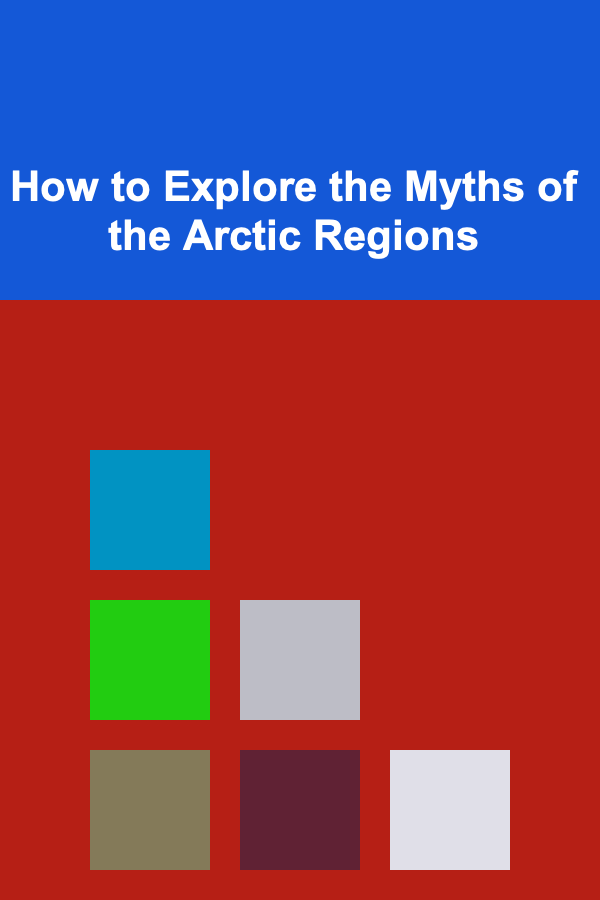
How to Explore the Myths of the Arctic Regions
ebook include PDF & Audio bundle (Micro Guide)
$12.99$11.99
Limited Time Offer! Order within the next:

The Arctic regions, often portrayed as isolated and extreme environments, have long been shrouded in mystery and myth. These myths, deeply embedded in both indigenous cultures and modern popular imagination, have shaped how we understand this frozen wilderness. From ancient tales of mythical creatures to modern-day exploration narratives, the Arctic's myths are not just fantastic stories but reflections of human curiosity, fear, and respect for the unknown.
Exploring the myths of the Arctic regions is not merely about retelling these stories, but about understanding their cultural significance, their origins, and their impact on the way we view the world today. The Arctic is a place where the boundaries between reality and myth often blur, where the harshness of nature meets the creativity of human imagination. This article delves into the various myths of the Arctic regions, their cultural contexts, the explorers who have sought to uncover the truth, and the modern understanding of these tales.
Understanding the Arctic's Mystical Aura
The Arctic has long been a source of wonder and fear, with its vast, icy expanses and long, dark winters. For centuries, it was a place that few people ventured to, and those who did often returned with stories of strange encounters, inexplicable phenomena, and creatures that defied logic.
The Geography of the Arctic
To fully grasp the nature of Arctic myths, it's essential to understand the geography of the region. The Arctic is defined as the area within the Arctic Circle, which includes parts of northern Canada, Alaska, Greenland, Russia, and Scandinavia. It is a land of ice, snow, and extreme cold, with temperatures that can plunge well below freezing. The region is largely inhospitable to human life, yet it is home to diverse indigenous communities, such as the Inuit in Canada and Greenland, the Sámi in Scandinavia, and the Chukchi in Russia.
The physical environment of the Arctic---its vast, barren landscapes, long polar nights, and shimmering Northern Lights---has inspired many myths and legends. Early explorers and indigenous people alike were drawn to the mysterious forces at work in this environment, and their stories reflect both the awe and fear that this region evokes.
The Role of Darkness and Light in Arctic Myths
One of the most striking features of the Arctic is its long periods of darkness during the winter months, followed by constant daylight in the summer. This extreme contrast has influenced many myths in the region. In some cultures, the long winter darkness was seen as a time when the forces of nature were most powerful, and spirits or supernatural beings were more active. In contrast, the return of the sun in the summer was often celebrated as a time of renewal and hope.
Indigenous Myths and Spiritual Beliefs
Indigenous cultures in the Arctic have rich mythologies that are deeply connected to the natural world. These myths often involve spirits, animals, and deities that govern the forces of nature, providing guidance and meaning to the lives of the people who inhabit these regions.
Inuit Mythology
The Inuit people, who live in the Arctic regions of Canada, Greenland, and Alaska, have a rich and complex mythology that is deeply tied to the land, sea, and animals. In Inuit culture, animals are often seen as spiritual beings, and many of their myths center around interactions with these creatures. One of the most famous Inuit myths is the story of Sedna, the sea goddess. According to Inuit legend, Sedna was once a beautiful woman who was cast into the sea by her father, where she became the ruler of the sea creatures. She controls the availability of marine life, and it is said that she can either bless hunters with an abundance of game or punish them with famine.
The Inuit also have myths about the Northern Lights, or "aurora borealis," which they believed to be the spirits of their ancestors. These lights were seen as signs of guidance or messages from the beyond. Some Inuit stories describe the lights as a bridge between the living and the dead, while others believed they were the spirits of animals that were trying to communicate with the living.
Sámi Myths and the Role of Shamanism
The Sámi people, indigenous to the northern parts of Scandinavia and Russia, have their own unique set of myths and spiritual beliefs. Central to Sámi mythology is the belief in nature spirits and deities that inhabit the natural world. These spirits were often invoked by shamans, or "noaidi," who acted as intermediaries between the human and spirit worlds. The Sámi believed that the Northern Lights, known as the "Aurora Borealis," were the spirits of the dead or mystical beings, and the lights' movements were considered to be a form of communication or warning.
In addition to spirits, the Sámi also believed in magical beings such as the "skåla," a type of giant or supernatural creature. These beings were often seen as protectors of nature and were believed to possess the ability to shape-shift, taking the form of animals or natural elements.
The Role of Exploration in Unveiling Arctic Myths
With the advent of exploration in the Arctic during the 16th and 17th centuries, the myths of the region began to be challenged. European explorers, driven by a desire for trade routes, scientific discovery, and territorial expansion, ventured into the icy wilderness, hoping to unlock its secrets. However, their expeditions often returned with their own stories of strange phenomena and encounters, some of which blurred the line between myth and reality.
The Search for the Northwest Passage
One of the most famous myths surrounding the Arctic was the quest for the Northwest Passage, a rumored sea route that would connect the Atlantic and Pacific Oceans through the Arctic Archipelago. For centuries, European explorers believed that this route existed and would provide a shortcut to Asia. However, every attempt to find the passage was met with failure, and many explorers perished in the harsh conditions of the Arctic. The myth of the Northwest Passage persisted for centuries, even after it became clear that the passage was either non-existent or impassable.
The search for the Northwest Passage led to some of the most famous tales of Arctic exploration, including the ill-fated expeditions of Sir John Franklin in the mid-1800s. Franklin's expedition, which set out to navigate the passage, became one of the most tragic and mysterious episodes in the history of Arctic exploration. When Franklin's ships, HMS Erebus and HMS Terror, became trapped in ice, the entire crew was lost, and no trace of them was found for over a decade. The fate of the crew remains one of the greatest mysteries of the Arctic, and many myths and legends have emerged surrounding their disappearance, including tales of cannibalism and supernatural forces at work.
The Arctic as a Land of Monsters
During the Age of Exploration, many sailors and explorers returned from the Arctic with tales of monstrous creatures inhabiting the region. Some of these stories were likely exaggerated or misunderstood accounts of real animals, while others were pure fantasy. For example, one of the most enduring myths was that of the "sea serpent," a giant, serpentine creature that was said to lurk in the waters around the Arctic.
Another famous Arctic myth involved the "Yeti" or "Sasquatch," a large, ape-like creature that was believed to roam the snowy mountains of the region. While the existence of such creatures has never been proven, stories of the Yeti persist to this day, particularly in the areas of Nepal and the Himalayas, though its connection to the Arctic is more a product of later myth-making.
Modern Perspectives on Arctic Myths
Today, the myths of the Arctic continue to capture the imagination of people around the world. While many of the more fantastical tales have been debunked or explained by scientific discovery, the stories still hold cultural significance and offer valuable insights into the human condition. The Arctic remains a place of mystery and fascination, and modern exploration, while far more advanced than in the past, continues to reveal new surprises about this harsh, beautiful land.
Climate Change and the Reawakening of Arctic Myths
In recent years, the Arctic has been undergoing rapid changes due to climate change. The ice that once dominated the region is melting at an alarming rate, revealing new landscapes and ecosystems. This dramatic transformation has led some to revisit the myths of the Arctic, particularly those related to the land's ancient origins and the powerful forces that govern it.
For example, the melting ice is revealing ancient fossils and artifacts that were once hidden beneath the ice. These discoveries have sparked renewed interest in the Arctic's past and have led to new stories about the land's history and the creatures that once inhabited it. Some even believe that the changing climate may be contributing to the resurgence of certain myths, as people seek to understand the forces behind these transformations.
The Arctic as a Source of Inspiration
Despite the harsh realities of Arctic exploration and climate change, the region continues to inspire artists, writers, and filmmakers. The Arctic has been the setting for countless works of fiction, from classic adventure tales like "Frankenstein" to modern thrillers such as "The Terror" by Dan Simmons. These works draw upon the enduring myths of the Arctic, blending history, legend, and imagination to create stories that resonate with audiences.
For many, the Arctic remains a symbol of both the unknown and the unconquerable. It is a place where myth and reality converge, where human resilience and the power of nature are tested to their limits. The myths of the Arctic may change over time, but their core themes---mystery, adventure, and the battle against the forces of nature---remain timeless.
Conclusion
Exploring the myths of the Arctic regions is an exploration of human culture, imagination, and the natural world. From the rich traditions of indigenous peoples to the daring tales of explorers and modern adventurers, the myths of the Arctic offer a window into how people have interpreted and understood one of the most remote and challenging regions on Earth. These myths, while often fantastical, reflect a deep-seated respect for the unknown and a desire to make sense of the world around us.
As we continue to explore the Arctic, both physically and mythologically, we are reminded of the power of storytelling to shape our understanding of the world. Whether we are seeking to uncover the truth behind ancient legends or create new myths for future generations, the Arctic remains a source of endless fascination, its mysteries waiting to be discovered.

How to Create a Modern Lighting Scheme for Your Home
Read More
How to Organize and Save Space in a Shared Bedroom
Read More
How to Understand and Manage Your Credit Card Debt
Read More
How to Train Neural Networks Effectively
Read More
How to Migrate Existing Systems to Blockchain
Read More
10 Tips for Displaying Your Antique Collection
Read MoreOther Products

How to Create a Modern Lighting Scheme for Your Home
Read More
How to Organize and Save Space in a Shared Bedroom
Read More
How to Understand and Manage Your Credit Card Debt
Read More
How to Train Neural Networks Effectively
Read More
How to Migrate Existing Systems to Blockchain
Read More